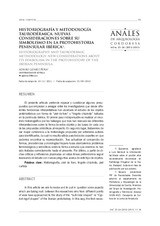Mostrar el registro sencillo del ítem
Historiografía y metodología taurodérmica: nuevas consideraciones sobre su simbolismo en la protohistoria peninsular ibérica
| dc.contributor.author | Gómez Peña, Álvaro | |
| dc.date.accessioned | 2018-01-08T08:34:24Z | |
| dc.date.available | 2018-01-08T08:34:24Z | |
| dc.date.issued | 2013 | |
| dc.identifier.issn | 1130-9741 | |
| dc.identifier.uri | http://hdl.handle.net/10396/15788 | |
| dc.description.abstract | El presente artículo pretende repasar y cuestionar algunos presupuestos que empiezan a arraigar entre los investigadores que desde diferentes tendencias interpretativas han abordado el estudio de los objetos protohistóricos con forma de “piel de toro” o “lingote chipriota” hallados en la península ibérica. El primer paso indispensable es realizar un recorrido historiográfico por los hallazgos que más han marcado las diferentes interpretaciones sobre la forma de estos objetos y las bases de cada una de las propuestas simbólicas al respecto. En segundo lugar, trataremos de dar mayor coherencia a la metodología propuesta por anteriores autores para identificarlos, la cual no resulta válida para todos los soportes en que podemos encontrar su representación. Tras actualizar el compendio de formas, procedencias y cronologías hispano-lusas abordaremos problemas terminológicos y simbólicos sobre la forma a estudio que creemos no han sido tratados correctamente hasta el presente. Por último, a partir de dichas críticas y reflexiones plasmadas en estas líneas pretendemos seguir reavivando el debate con nuevas preguntas acerca de este tipo de objetos. | es_ES |
| dc.description.abstract | In this article we aim to revise and to put in question some aspects which are taking root between the researchers who from different points of view have approached to the study of the “bull-hide shaped” or “Cypriot ingot shaped” of the Iberian protohistory. In this way, the first necessary step is to carry out a historiographic revision of the most remarkable findings which have conditioned the different interpretations about the shape of these objects and the starting point of the symbolic proposals about them. Secondly, we try to give more coherence to the methodology published by other authors to identify them, because it does not enough accurate to all the supports in which we can find its representation. After bringing up to date the list of forms, origins and cronologies of them, we try to set an approach of the terminological and symbolic problems about its shape that have not been well-studied until the present. Finally, from such reviews and reflections published in these lines we want to continue the debate with new questions about this type of objects. | es_ES |
| dc.format.mimetype | application/pdf | es_ES |
| dc.language.iso | spa | es_ES |
| dc.publisher | Universidad de Córdoba, Área de Arqueología | es_ES |
| dc.rights | https://creativecommons.org/licenses/by/3.0/ | es_ES |
| dc.source | Anales de Arqueología Cordobesa 23-24, 11-34 (2012-2013) | es_ES |
| dc.subject | Historiografía | es_ES |
| dc.subject | Piel de toro | es_ES |
| dc.subject | Lingote chipriota | es_ES |
| dc.subject | Piel curtida | es_ES |
| dc.subject | Historiography | es_ES |
| dc.subject | Bull-hide | es_ES |
| dc.subject | Cypriot ingot | es_ES |
| dc.subject | Tanned skin | es_ES |
| dc.title | Historiografía y metodología taurodérmica: nuevas consideraciones sobre su simbolismo en la protohistoria peninsular ibérica | es_ES |
| dc.title.alternative | Historiography and taurodermic methodology: new considerations about its symbolism in the Protohistory of the Iberian Peninsula | es_ES |
| dc.type | info:eu-repo/semantics/article | es_ES |
| dc.relation.publisherversion | https://www.uco.es/ucopress/ojs/index.php/anarcor/index | es_ES |
| dc.rights.accessRights | info:eu-repo/semantics/openAccess | es_ES |

